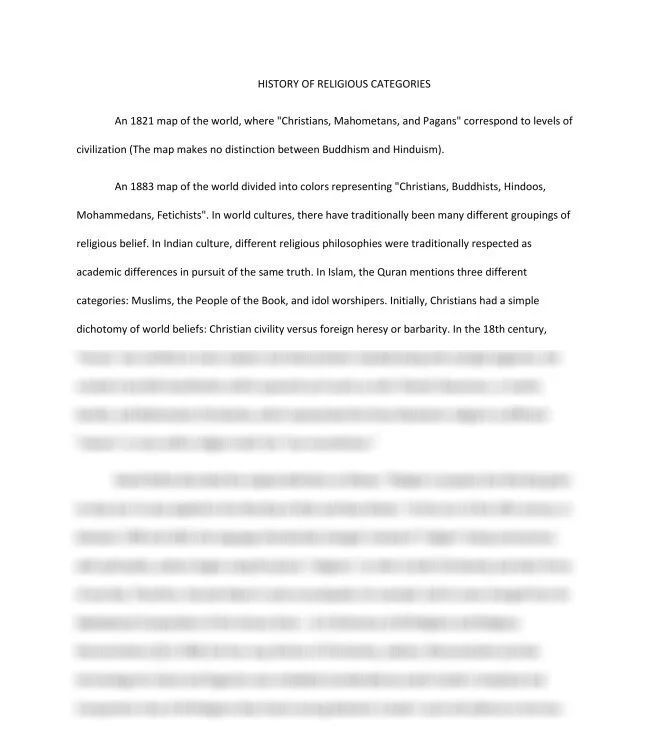HISTORY OF RELIGIOUS CATEGORIES The rising cost of medical care in the United States has been a concern for quite some time. Beginning in the 1960s with the advent of Medicare, a system has been neede
HISTORY OF RELIGIOUS CATEGORIES The rising cost of medical care in the United States has been a concern for quite some time. Beginning in the 1960s with the advent of Medicare, a system has been neede
"Brahminical "Christians, "Religion "Vedas, "heresy" "illiterate "invention "nations" "polytheism "religion "religion" "religions", "true "world 'tis (The (archaic 1780 1810, 1821 1838, 1883 1893Parliament 18th 19th 20th A Abrahamic Adams's Alan All Alphabetical An Analytical At Book, Buddhism Buddhism, Buddhists, CATEGORIES Chicago, China Christian Christianity Christianity, Christians Christians, Comparative Compendium Conder's D. Daniel Defoe Deities." Denominations.[3] Dictionary Druze, Elamites[clarification Even Extant Fetichists". Gentile, God, Hannah Hindoos, Hinduism). Idols Illinois. In India Indian Initially, Islam) Islam, Islam;[citation Jainism, James, Japan", Jewish, John Josiah Judaism Judaism, Lamaism, Mahometan Mahometans, Mandeans, Mankind. Mohammedans, Monometalism Muslims, Nazarenes, Now OF Others Paganism Pagans" Parliament People Puranas, Quran RELIGIOUS Reformed Religions Religious Sects... Sikhism, Suzuki, T. Tantras, The Therefore, Toland's Various View Watts, Western William World's Worship Yezidis, Zoroastrianism, a academic adheres advise against along also among an and applied arbitrary as at authors barbarity. been began being belief. beliefs: between both but by categories: category category, century, changed changed: civility civilization clarified classification classification, colors complications conception considerably context correspond create created creating creation culture, cultures, definition described detail dichotomy differences different distinction diversity divided division dozen dramatically drawing early encyclopedia, especially example, experience: eye false fell final five follows: for foreign forms four four-way fourfold from funded given greatly groupings groups, had half have he heresy his historical history idol idolatry", image: in includes influenced informing instead intent into is its itself, language latter lectures level levels list lists living makes many map mean meaning mentions modern monotheism." monotheistic much multiplied name nation-state needed] no non-Christians note now of one or original other our outright paganism, pantheism", parallels people philosophies phrase plural, possibly privately professors properly public pursuit puts putting question, refer religion religion" religion", religions religions" religions.[5] religious represented representing researchers resembling respected same same, schools.[7] sects sects" secular.[6] see separation serious shaping simple six something spawned spirituality, spurred still such superstitions".[4] synonymous taken teaching terminology the there thereby these this three to together traditionally traditions". truth. turn two twoHISTORY under using vastly versus was well were where which who with within work works world world, worship. worshipers.
HISTORY OF RELIGIOUS CATEGORIES
An 1821 map of the world, where "Christians, Mahometans, and Pagans" correspond to levels of civilization (The map makes no distinction between Buddhism and Hinduism).
The rising cost of medical care in the United States has been a concern for quite some time. Beginning in the 1960s with the advent of Medicare, a system has been needed that will balance cost with services provided within acceptable parameters. In 1982, the US Congress placed a cap on operating expenses for each Medicare case treated in a hospital, as a protective measure to insure adequate payment within reasonable limits. A prospective payment system (PPS) was initiated as a result of the cap, whereby hospitals receive a flat rate for each admission based on a calculation of rates determined by the diagnosis (Kahn, et al, 2019). A system whereby the diagnosis is grouped according to services, estimated length of stay and type of technology required for treatment was developed by Robert B. Fetter and John D. Thompson in the early 1980s (Burke, 2019). The diagnostic related groups (DRGs) form the basis for the payment system. This system was originally set up for use with Medicare but has been refined and expanded to include non-Medicare situations in the United States and abroad. Some form of DRGs has been adopted in more than 20 countries,
